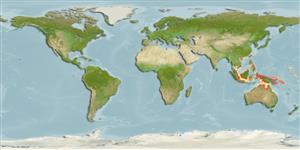分类 / Names
俗名 | 同种异名 | Catalog of Fishes(属, 种) | ITIS | CoL | WoRMS | Cloffa
Environment: milieu / climate zone / depth range / distribution range
生态学
海洋; 半咸淡水 底中水层性. 熱帶
Western Pacific: northern Australia and southern New Guinea.
西太平洋: 澳洲北部與新幾內亞南部。
大小 / 重量 / 年龄
Maturity: Lm ? range ? - ? cm
Max length : 39.5 cm SL 雄鱼/尚未辨别雌雄; (Ref. 30691)
背棘 (总数) : 1; 臀鳍软条: 22 - 25. Body coppery, golden brown, bronze or greyish pink. Dorsomedian head groove deep and elliptical posteriorly. Long barbels with maxillary pair 30 - 56% of SL; bases of chin barbels well separated and staggered. Gill rakers largely absent from hind aspect of the first 2 gill arches. Dorsal fin spine with a short filament at all ages (Ref. 38478).
身体黄铜色的,金褐色,和青铜色或略灰色的粉红色。 背面中央的头部凹槽很深与在后部地的椭圆形。 长的触须有颚骨对 30- 56% 的 SL; 下巴触须的基底分得很开而且交错。 鳃耙主要地第一个的后部面 2个鳃弓没有出现。 背鳍棘具有一个短的丝状突起,所有大小年龄的鱼.(参考文献 38478)
Inhabits coastal waters and estuaries, river deltas and rivers within tidal influence. Feeds mainly on prawns and other crustaceans, fish, aquatic insects, plant material, and fish scales taken opportunistically (Ref. 38478).
栖息于潮汐的影响力里面的沿岸水域与河口,河三角州与河。 主要吃虾与其他的甲壳动物,鱼,水生昆虫,植物与鱼鳞随机取食.(参考文献 38478)
Life cycle and mating behavior
成熟度 | 繁殖 | 产卵场 | 卵 | 孕卵数 | 仔鱼
西太平洋: 澳洲北部與新幾內亞南部。
Kailola, P.J., 1999. Ariidae (=Tachysuridae): sea catfishes (fork-tailed catfishes). p. 1827-1879. In K.E. Carpenter and V.H. Niem (eds.) FAO species identification guide for fishery purposes. The living marine resources of the Western Central Pacific. Vol. 3. Batoid fishes, chimaeras and bony fishes part 1 (Elopidae to Linophrynidae). FAO, Rome. (Ref. 38478)
世界自然保护联盟红皮书 (Ref. 130435: Version 2024-1)
人类利用
工具
特别资料
下载 XML
网络资源
Estimates based on models
Preferred temperature (Ref.
123201): 26.7 - 29, mean 28 °C (based on 298 cells).
Phylogenetic diversity index (Ref.
82804): PD
50 = 0.5156 [Uniqueness, from 0.5 = low to 2.0 = high].
Bayesian length-weight: a=0.00490 (0.00250 - 0.00959), b=3.13 (2.96 - 3.30), in cm total length, based on LWR estimates for this (Sub)family-body shape (Ref.
93245).
营养阶层 (Ref.
69278): 3.7 ±0.4 se; based on diet studies.
回复力 (Ref.
120179): 中等的, 族群倍增时间最少 1.4 - 4.4年 (Preliminary K or Fecundity.).
Fishing Vulnerability (Ref.
59153): Moderate vulnerability (38 of 100).
